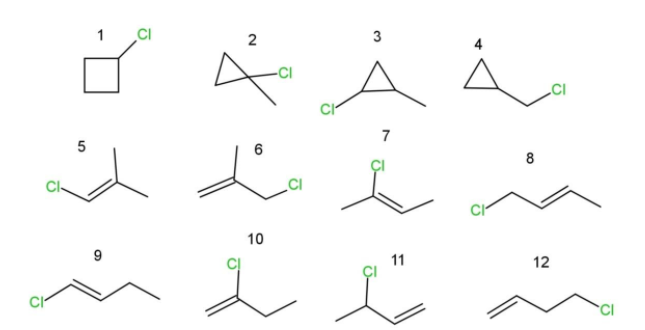
How can I draw the structural formulas for all the isomers of ${{C}_{4}}{{H}_{7}}Cl$? Are there any enantiomers or diastereomers?
Answer
522k+ views
Hint: Isomers of a compound are the different structures that can be made from the empirical formula of the compound. Enantiomers and diastereomers, both contain a chiral centre.
Complete answer:
We are given the empirical formula ${{C}_{4}}{{H}_{7}}Cl$ of a compound and to draw its possible structural isomers. For drawing the isomers of ${{C}_{4}}{{H}_{7}}Cl$, first we need to see the total carbons in this compound and the presence of double bonds.
When we remove Cl from ${{C}_{4}}{{H}_{7}}Cl$ and add hydrogen, we get ${{C}_{4}}{{H}_{8}}$. But alkane with 4-carbons (butane) has a formula ${{C}_{4}}{{H}_{10}}$, this shows that a double bond is present in the compound ${{C}_{4}}{{H}_{7}}Cl$.
From the formula of ${{C}_{4}}{{H}_{8}}$, which is butene, we can draw :
-6 isomers of 4-carbon with Cl at different positions
- 2 isomers of 3-carbon chain with Cl at different positions
- 1 isomer of cyclobutane with Cl at different positions
- 3 isomers of cyclopropane with Cl at different positions
This sum ups all the structural isomers of ${{C}_{4}}{{H}_{7}}Cl$, which are 12 in number as follows:

Among these 12 structural isomers, we have some of them as enantiomers and some as diastereomers.
- isomer 3 can have four pairs of enantiomers possible.
- isomer 11 can have two enantiomers possible.
- isomer 2 can have two diastereomers.
- isomers 8 and 9 have two pairs of diastereomers .
- also isomer 3 can have two diastereomers.
This makes the total isomers, including enantiomers and diastereomers, to be 18.
Hence, ${{C}_{4}}{{H}_{7}}Cl$ have 12 structural isomers, and 6 pairs of enantiomers while 6 pairs of diastereomers , which makes a total 18 isomers.
Note:
Enantiomers and diastereomers, both have a chiral centre and are non-superimposable, but they differ in being mirror images. As enantiomers are mirror images, while diastereomers are not.
Complete answer:
We are given the empirical formula ${{C}_{4}}{{H}_{7}}Cl$ of a compound and to draw its possible structural isomers. For drawing the isomers of ${{C}_{4}}{{H}_{7}}Cl$, first we need to see the total carbons in this compound and the presence of double bonds.
When we remove Cl from ${{C}_{4}}{{H}_{7}}Cl$ and add hydrogen, we get ${{C}_{4}}{{H}_{8}}$. But alkane with 4-carbons (butane) has a formula ${{C}_{4}}{{H}_{10}}$, this shows that a double bond is present in the compound ${{C}_{4}}{{H}_{7}}Cl$.
From the formula of ${{C}_{4}}{{H}_{8}}$, which is butene, we can draw :
-6 isomers of 4-carbon with Cl at different positions
- 2 isomers of 3-carbon chain with Cl at different positions
- 1 isomer of cyclobutane with Cl at different positions
- 3 isomers of cyclopropane with Cl at different positions
This sum ups all the structural isomers of ${{C}_{4}}{{H}_{7}}Cl$, which are 12 in number as follows:

Among these 12 structural isomers, we have some of them as enantiomers and some as diastereomers.
- isomer 3 can have four pairs of enantiomers possible.
- isomer 11 can have two enantiomers possible.
- isomer 2 can have two diastereomers.
- isomers 8 and 9 have two pairs of diastereomers .
- also isomer 3 can have two diastereomers.
This makes the total isomers, including enantiomers and diastereomers, to be 18.
Hence, ${{C}_{4}}{{H}_{7}}Cl$ have 12 structural isomers, and 6 pairs of enantiomers while 6 pairs of diastereomers , which makes a total 18 isomers.
Note:
Enantiomers and diastereomers, both have a chiral centre and are non-superimposable, but they differ in being mirror images. As enantiomers are mirror images, while diastereomers are not.
Recently Updated Pages
Master Class 11 Economics: Engaging Questions & Answers for Success

Master Class 11 English: Engaging Questions & Answers for Success

Master Class 11 Social Science: Engaging Questions & Answers for Success

Master Class 11 Biology: Engaging Questions & Answers for Success

Class 11 Question and Answer - Your Ultimate Solutions Guide

Master Class 11 Business Studies: Engaging Questions & Answers for Success

Trending doubts
What is meant by exothermic and endothermic reactions class 11 chemistry CBSE

What are Quantum numbers Explain the quantum number class 11 chemistry CBSE

What is periodicity class 11 chemistry CBSE

Explain zero factorial class 11 maths CBSE

What is a periderm How does periderm formation take class 11 biology CBSE

Mention the basic forces in nature class 11 physics CBSE




